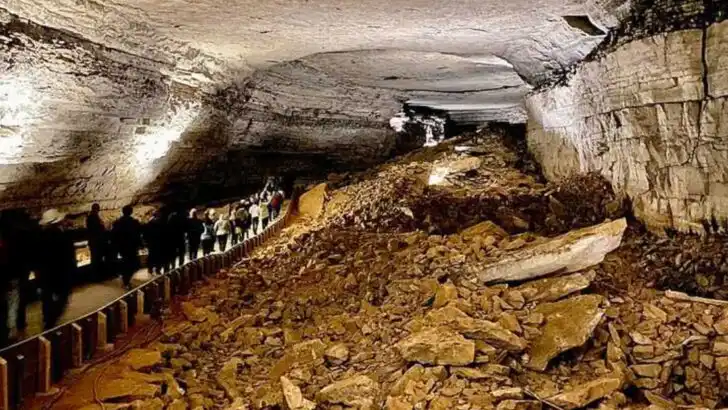Beneath the rolling hills of Kentucky lies a hidden world—dark, endless, and alive. This isn’t just a cave. It’s the world’s longest cave system, a twisting maze that stretches for more than 400 miles under the earth. Some say it feels like stepping into another planet—where rivers vanish underground, chambers echo like cathedrals, and ancient secrets sleep in the stone.
Known as Mammoth Cave, this underground wonder has swallowed centuries of explorers, legends, and scientific discoveries. And it’s still growing. New passages are being found even today, proving that the world beneath Kentucky is far larger—and far wilder—than anyone ever imagined.
Ancient Origins
Millions of years ago, the area now known as Mammoth Cave was covered by a shallow sea. Layers of limestone formed, which were later sculpted by water into the vast cave system.
The cave’s formation is a testament to nature’s relentless artistry, creating a hidden world beneath the surface.
Today, parts of the cave still echo with the whispers of its ancient origins, attracting geologists seeking to unveil its secrets.
Unique Ecosystem
Mammoth Cave is not just a marvel of geological formation; it harbors a unique ecosystem. Blind cave fish and other specialized creatures thrive in its darkness.
This ecosystem has adapted to the absence of light, evolving unique traits that fascinate biologists and ecologists alike.
The interplay between these creatures and their environment offers insights into adaptation and survival in extreme conditions.
Historical Significance
The corridors of Mammoth Cave have witnessed human footsteps for thousands of years. Native Americans explored its depths long before European settlers arrived.
Later, the cave became a site of saltpeter mining during the War of 1812. Visitors today can walk the same paths as those early explorers.
This historical tapestry adds a rich layer to the cave’s allure, drawing history enthusiasts to its dimly lit passages.
The Grand Avenue
The Grand Avenue is a highlight of Mammoth Cave tours, showcasing the cave’s majestic scale. This expansive passage stretches for miles, adorned with stunning formations.
Walking through it feels like being inside a natural cathedral, with its grandeur leaving visitors in awe.
It’s a reminder of the cave’s immense size and the artistic beauty carved by the patient hand of time.
Role in Speleology
Mammoth Cave has played a pioneering role in the field of speleology, the study of caves. Scientists continuously explore its depths to understand geological processes.
The cave’s extensive network provides endless opportunities for discovery, making it a hub for research and learning.
Through their studies, researchers unravel the mysteries of cave formation, contributing significantly to our understanding of Earth’s subterranean landscapes.
Mysterious Echo River
The Echo River, flowing quietly beneath the cave, adds an air of mystery to Mammoth. This underground waterway supports a hidden world of aquatic life.
Its presence raises questions about subterranean hydrology and the interconnectedness of Earth’s waterways.
Explorers and scientists are drawn to its enigmatic flow, seeking to map its course and unlock its secrets.
Trapping Caves’ Secrets
Exploring Mammoth Cave is akin to a treasure hunt, with new passages waiting to be discovered. Spelunkers embark on expeditions, hoping to reveal untold stories.
Each new passage adds to the intricate map of the cave, expanding our understanding of its vastness.
The thrill of discovery and the promise of uncovering more hidden wonders keep adventurers returning to its depths.

